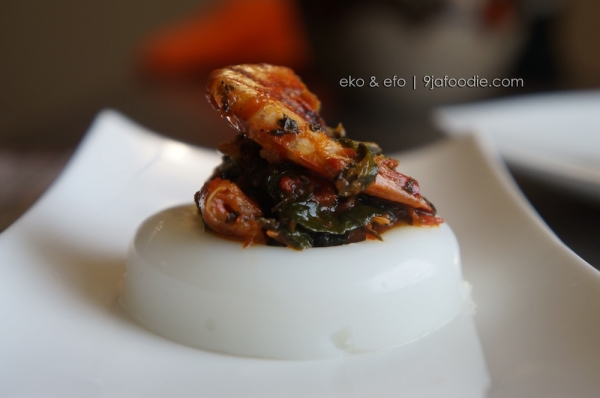
Eko (Agidi) and Vegetable Soup (Efo)
List of Nigerian Vegetables used for cooking
This post was inspired by Eko & Efo, a pride food combination amongst my father’s people. Efo (Vegetable) is the most important part of the meal combination and it’s therefore prepared with much finesse. This meal brought about a conversation on Nigerian vegetables that are used in soup preparation and we decided to put together a list:
Efo Yanrin (Wild Lettuce)
English Name:Dandelion greens Local Name: Efo Yarin (Yoruba) Botanically: Taraxacum officinale, Family Asteraceae
The leaves of this vegetable plant are eaten fresh as a salad or cooked in soups and sauces. The plant is often grown for cropping the leaves which are sold in markets cooked or rolled up balls. The mineral content of the leaves is known to be relatively high (21.8%).
Efo ewuro (Bitter leaves):
English Name: Bitter leaf Local Name: Ewuro (Yoruba) Botanically: Vernonia amygdalina, Family Compositae
The bitter leaf is a very important vegetable for most Nigerians, it can be purchased in many markets throughout the year and it’s planted commonly in home gardens. Wherever it grows, it flourishes. There are several species; some large, leafy and deep green leaves, while some have comparatively smaller leaves. As the name implies, the leaves are very bitter;the bitterness is usually removed by washing or boiling the leaves.
Efo Tete (African Spinach):
English Name: African Spinach, Callaloo Local Name: Efo Tete (Yoruba) Botanically: Amaranthus hybridus, Family Amaranthaceae
This vegetable is a perennial herb. As expected, it is in great abundance during the rainy season. Historically, it is said to reach West Africa from Asia. The stem and leaves are edible. The plant grows in three main colors (Pink, deep red and green); the colored varieties are planted for decorative purposed in North America. The green colored variety is the only consumed assortment in Nigeria.
Efo Shoko:
English Name: Lagos Spinach Local Name: Shokoyokoto (Yoruba) Botanically: Celosia argentea, Family Amaranthaceae
The “Lagos Spinach” is a very popular vegetable in Lagos Metropolitan area markets. It is commonly sold during raining season. A perennial herb, the flavor profile is slightly bitter and the leaves are slightly diuretic. While being cooked, its slight bitterness is counteracted by the addition of ground melon and condiments. The Yoruba’s call it “sokoyokoto”, to emphasize the esteem in which the vegetable-plant is held ‘Sokoyokoto” means “make husband fat”
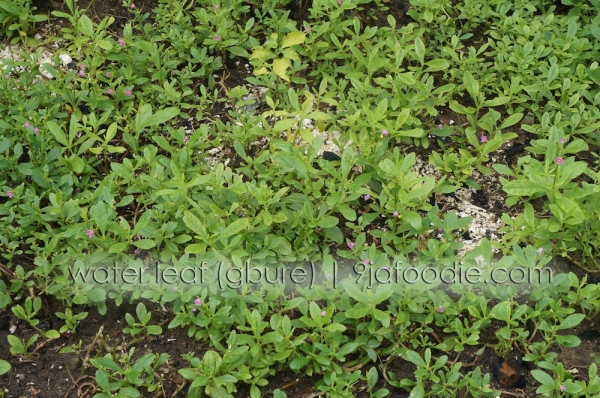
water leaf
Gbure (water leaves)
English Name: WaterLeaf Local Name: Gbure (Yoruba) Botanically: “Talinum Triangulare, Family Portulacaeae”
As the name implies, the waterleaf vegetable is extremely abundant during the rainy season. Ironically, the waterleaf plant is scientifically classified as a weed. The plant is very easily propagated by cuttings and by seeds; it has a quick growing and short life cycle. The vegetable is eaten cooked, in salads and in soups. It is reported by experts to be rich in mineral salts and amino acids as well as having anti-scorbutic properties.
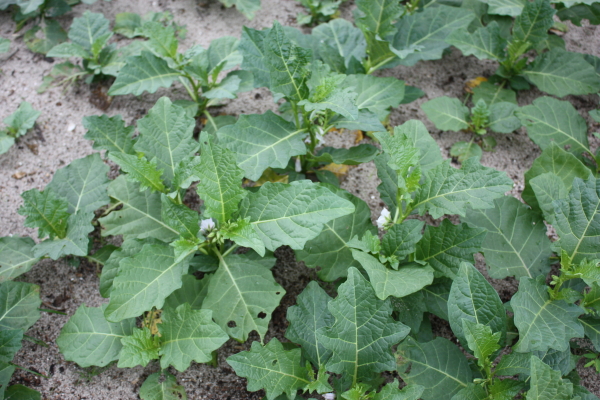
efo Igbo (Garden egg plant)
Efo Igbo (Eggplant leaves):
English Name: African Egg Plant leaf Local Name: Efo Igbo (Yoruba) Botanically: Solanum macrocarpon, Family Solanaceae
The ‘African Egg Plant” is one of the most glamorous vegetables in Lagos Area Markets. The vegetable does not come to the market in comparatively large quantities like the others; it is cherished amongst the Yoruba people. The plant is usually cultivated for its leaves, which are a bit bitter; the fruits are eaten occasionally but are mainly preserved for purposes of propagation.
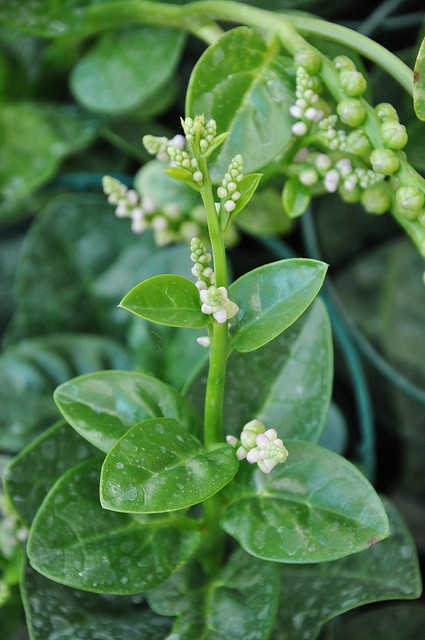
efo amunututu (spinach)
Amunututu:
English Name: Malabar Spinach Local Name: Amunututu (Yoruba)Botanically: Basella alba, Family Basellaceae
This vegetable is an Afro-Asian plant. Locally, it is known as “amunututu” which literally means “a cool appetiser to the stomach” and also ‘Toromoganna”, which means ‘a wall climber”.
The leaves are succulent with high water content. It is both an annual and/or short lived perennial. The flavour profile is mild and the texture is mucilaginous (similar to aloe vera). This vegetable is high in calcium and iron and to be a good source of vitamins A, B and C; Rich in protein and a good source of soluble fiber.
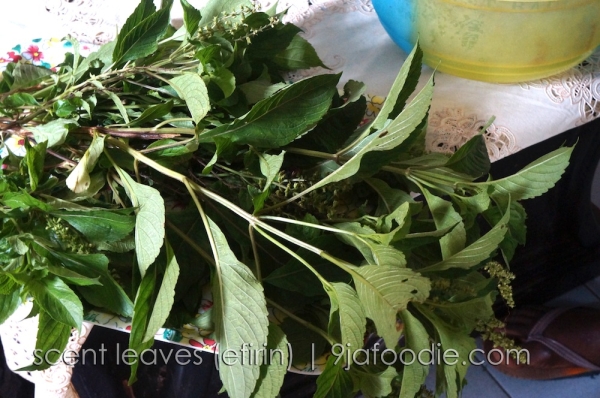
scent leaf (efirin)
Efinrin: African blue basil (scent leaf)
Botanically: Ocimum gratissimum, Family Labiatae
“Efirin” (scent leaf) is an important vegetable sold across the country because of its manifold medicinal usages, it’s also commonly grown around houses as a mosquito repellant.
For the longest time, I assumed African blue basil and African Basil were the same, they are not. The most notable difference being that the leaves of African blue basil start out purple when young, only growing green as the given leaf grows to its full size, and even then retaining purple veins. It is believed that African basil has analgesic that is why it’s an essential part of meals prepared for women postnatal.
Ebolo:
English Name: Yoruban bologi Local Name: Ebolo (Yoruba) Botanically: Crassocephalum rubens, Family Comopositae
“Ebolo” is an uncommon vegetable, it is sold only after the arrival of the new yam, deep into the rainy season. The whole young plant and the semi succulent leaves are mucilaginous and are a potherb eaten in soups and sauces. The leaves are slightly laxative
Afang Leaves:
English Name: ? Local Name: Afang (Ibibio), Okazi (Igbo) Botanically: Gnetum africanum, Family Gnetaceae
This vegetable is very popular among the ethnic peoples of southern and southeastern Nigeria. The Efik and Ibibio peoples call it ‘afang’ while the Igbo’s call it “okazi”. The plant is not cultivated; the leaves are collected as forest products.
Afang is a significant source of protein, carbohydrates, essential amino acids (non essential amino acids and mineral constituents i.e. macro and micro-elements
Ugu:
The leaves and young shoots of the “ugu” vegetable are frequently eaten as a potherb and cooked as soups. Ugu is believed to be the most eaten vegetable among the Ibo speaking people. There are several purported nutrition and health benefits of Ugu , substantial research is lacking. Ugu is efficient in building up or renewing cells and tissues as well in the treatment of anaemia (Ukwuoma and Mauaya,2005 and Beck,1980 ).
p.s. – “There is no Yoruba name for parsley, as it is not originally West African. You can get the seeds and plant them, they will grow in tropical and sub tropical, will grow in the summer in temperate countries. “
What is your vegetable of choice for soups? If you have any other vegetables to add to the list please email us – [email protected] or leave comment below.
Click here for our authentic efo riro recipe.
Much gratitude and credit to Mr S.O Disu for his inexhaustible archive.

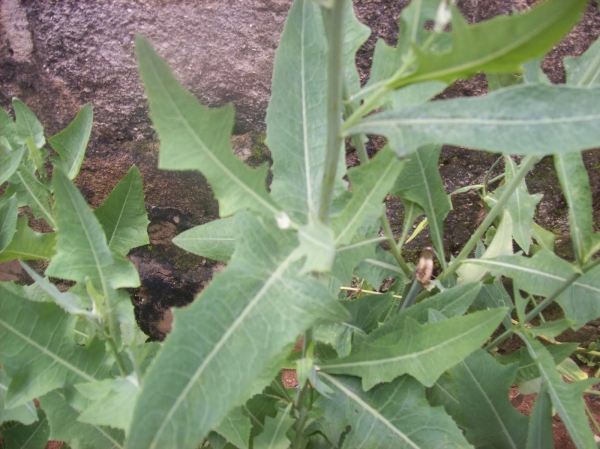
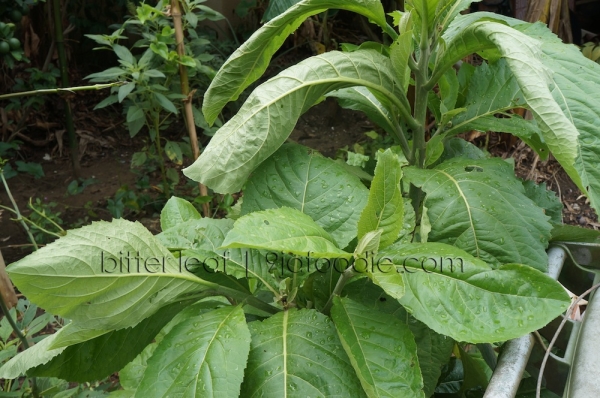
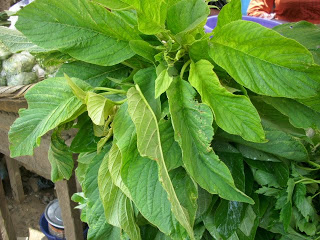
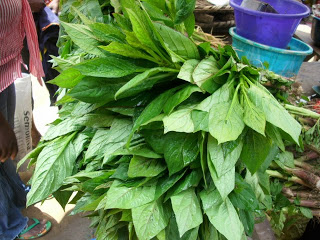
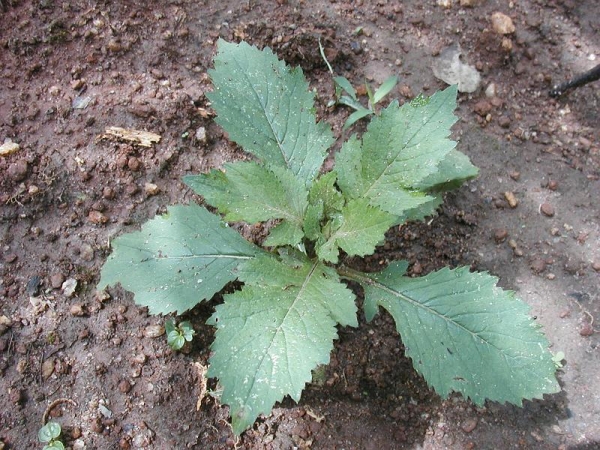
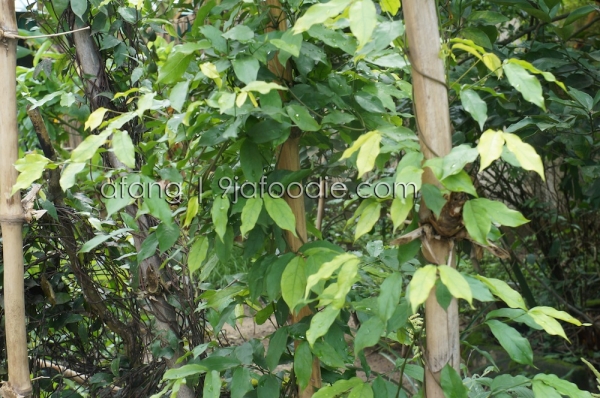
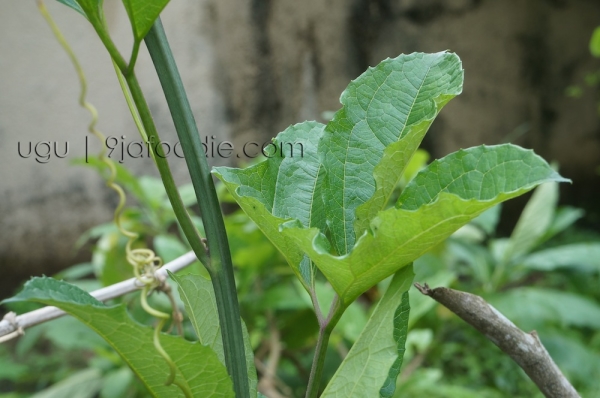




Please what is the english of efo ori
.please what is odun ju eja lo leaf in englisn
It means “It’s sweeter than fish”
Comment… Please, what are the names of plants use for energizing the body?
Thanks for this site may god bless you. What is the english name of Eku
.I thought Efinrin is in mint family??
thank you
What vegetables are Aiba and ama in English?
Comment…Please confirm if the “efo odu” with balloon-like flower is edible
No efo odu is not consumable rather you can take ewuro odo Leave or Yanrin.
Efo odu is very much consumable sir/ ma.
Very educative article. Thank you 😊👍
There are more leaf vegetables in yorubaland which are not known universally, one is called, ogumọ.
Odu is edible
I learnt African Spanish and tefairia occidentalism
What is the English word for the yoruba plant ewe Òsùn. Thanks
Am so much impressed, pls what is the Igbo name for fat leave? And where can one get it? I wand to research on medicinal plants or leaves ,pls I need important plant leaves that could be of good help to research studies.
Please guys am from igbo tribe, please i need English name for ochakuru, and nturukpa?
Yoruba name for “Ugu” is “Eweroko”, while ibo name for waterleaf is “Polobi or Porobi” and in Efik or Ibibio waterleaf is called “Momoi-kong”.
Anyone with the Yoruba name for Broccoli.
That Efo Igbo is Igbagba in Yoruba and Efo Odu is 200% edible
Nice one. U help out on a project today.
So educative
What is the English name for Ewe Taba leaf.
Tobacco leaves
What is Coriander seed and leaf called in Yoruba language
.I thought Efinrin is in mint family??
I really appreciate this write up, thank you
Thanks for this, it was helpful but you have to correct something. It’s called Afang both in Ibibio and Efik, not just Ibibio.
Ewe Taba is Tobacco leaf in English
I supposed igbo is weed or Marijuana as opposed to igba for the vegetable? Correct my ignorance.
Thanks for sharing
Please, can anyone tell me what is Fat Leave, someone who have used it to clear and melt her fibroid.. And I have it and she said one of the Leaves she used is Fat Leave and truly i don’t know which leave is that… Please, help me out as I am really suffering and do not want to go for any ..I will really appreciate your kind help.
This is awesome. I’m a lover of green smoothies so I’ve been researching on the native greens we have here in Nigeria and the ones that are drinkable raw.
Thank you so much for this
Please, I really need a help … My flow stopped about 3 years now and I have gone for hospitals and after treatment I either I flow for 6 days and it stop coming and to another place it came just 3 days on the treatment…And now fibroid is in and truly disturbing me alot and I have been searching solution and it’s not fast coming and I need a herbal/leave treatment urgently because people said it will be the fast way of getting the fibroid out in my tommy… Please is there any kind of live you can direct me to use? Please helo your sister out.
Thanks,
Theresa.
hello Theresa, if you have been on medications and fibroid is not reducing, then please opt for a surgery. its easier and the best means. please see a renowned gyneacologist to help out. I know, because i have been in your shoes…. i actually had it for over 3 years, treated it the ‘chinese’ way… drugs and all the likes until, the flow started coming and never stopped. I got lucky, or is it blessed? it stopped for a few days and we operated on it within those few days. its been 3 years. had my second child after the fibroid removal. so, i hope my testimony helps and encourages you to go for it. The good Lord is on your side. amen.
9jafoodie ma, your blog is lit!
Efo ajefoawo? Please do research on it and worowo thanks
What is hygiene
conditions or practices conducive to maintaining health and preventing disease, especially through cleanliness.
Good job & very educating, please can someone help me with efo odu; details please? Thank. ADEYEMO, O. P.
Solanum nigrum is a medicinal plant belonging to Solanaceae family. In Africa, it is locally named Efo Odu , Gautan Kadii among other names. it is also commonly referred as Black-Nightshade, Wonder Berry.The plant’s healing properties are extracted from the whole plant.The plant is used for the treatment of convulsion, malaria, gonorrhoea, inflammatory swellings, skin diseases, ringworms, boils, heart diseases, tonic, suppuration.
What is English and botanical name for Ewedu
Jute leaves
where can I find scent leaf in the US? What is the English Name that I can find it under?
Grocery stores. Herbs section. It’s called Basil.
Basil is a sub. The Nigerian Variety isn’t available in the US.
Please what is the local name for coriander leave, and I want to see the picture!
In the US, coriander seeds are called cilantro but in Europe cloth seeds and leaves are called coriander. The Yoruba name for coriander is Ebolo.Picture cant be posted here
What is jute leaf in efik or ibibio please
Very educative post on list of vegetables. Many thanks. Pls what’s the local name for collard greens? Where can I find it in Warri, Nigeria?
Thanks for sharing this useful information.
Pls what is the English name for efo elegede
Pumpkin (cucurbital pepo)
Please what is the botanical name of efuo(esan)
I guess this is the Edo (Benin/Esan) black soup. Simply a combination of Bitter leaf and effirin (scent leaf)
Dear 9ja foodie, thanks for the elucidating post. I’d like to know which of these leafy greens are safe to steam for a few minutes and consume with a few sprinkles of spices of choice. I steam Efo amunututu(spinach) and Ugu regularly and they’re so delicious and great attacks o body fat. The Ugu takes a slightly longer time to tenderize in the steam pot. Any other safe ones on this list to steam and spice up for healthy consumption?
Please what’s the local name for parsley leaf?
Parsley leaf popularly known as Scent leaf in the western part of Africa, fondly and Locally known as “Effirin” in the Yoruba language
Pls what is kale leave in Yoruba. I really need but can’t get it
kale is a member of the cruciferous vegetable family which includes cabbage, Brussels sprouts, cauliflower e.t.c. the Yoruba have nicknamed it Ewe Akintola(Akintola’s leaf) or Ewe Awolowo(Awolowo leaf)
Modesina plant, anybody knows?
nice job..please can u tell me the local names for broccolli, spinach and kale
kale-Ewe Akintola(Akintola’s leaf) or Ewe Awolowo(Awolowo leaf).
In Yoruba, Spinach is called Efo tete
Dont know about brocolli
God bless you 9jafoodie. There’s a lot to learn from here.
@Enoh Bassey:
Ewe akintola is Siam weed. The botanical name is Chromolaena Odarata.
Kale is efo igbo or igba in Yoruba, and this is commonly known as African eggplant leaf.
Efinrin is scent leaf, not parsley.
Parsley and scent leaf are two different vegetables.
What is English and botanical name for Ewedu
So interesting and educative
What is mint leaf in yoruba
Mint leaves in Yoruba is Efinrin
No, it’s not. Efirin is African Blue Basil
Mint leaf is popularly called “Ewe mint” in the Yoruba language.
great job up there, english name for efo gbagba please anyone
Efo igbagba is the same as Efo igbo discussed above
The leaf of the garden egg, called akwukwo anara in Ibo and efo gbagba / Efo Igbo in Yoruba. Hausa call it ganyen gauta
Thanks so much for the info. It’s interesting and educative.
Comment…hello people, I’ve read all the post and searched through the comment, but i still can’t find the local name for parsley leave, please i need answer for that,it’s there anyone who knows?
Hello good day to everyone, have a wonderful time thanks
Good day everyone, can anyone tell me the Yoruba name for alfalfa leaves
hi house!
could you believe I never all this vegetables except for efo tete , efo shoko, Ewuro, Amunututu, Gbure and Ewedu. I never knew the rest are eatable vegetables despite seeing most of them in the market, and I will be claiming one confirm Yoruba girl. but all thanks to 9jafoodie sha happy am here!!!
Please what is the English name for isapa
There is Efo Iyana Ipaja.. It is also very delicious but it scrashes the skin.. U have to wear a protection on ur hand before u can pluck… Pls help me with the Yoruba name for coriander… It appears it’s Ewedu in a picture I saw…
Sorry I dont know the yoruba name for coriander but it’s not ewedu. ewedu is jute leaf.
I also think coriander is ebolo
WRONG. the leaves are not even close in size.
pls what is yoruba name for beetroot and where can one get both for planting and consumption
Beetroot is sold in the vegetable market , such as where salad ingredients are sold, some times some malams carries it about in a wheelbarrow with other vegetables, but if you want many, then you can go to mile 12 market if you are in Lagos
What is the Nigeria or Yoruba name for chocory leave
Chicory I mean
I guess Ebolo is Parsley/coriander
No it isnt
Do you know English name for efo worowo. It grows under there cocoa plantation
I dont know, sorry.
Please what is the English name for Ewe Taba.
What is coriander in Yoruba
No idea
Coriander is efo ebolo
Sorry but it’s not. they are two different vegetables.
Please what is the English name of Efo Igbo and Efo Odu. Thank you.
what is the yoruba name for mint leaves?
Ewe taju taju
I love all this vegetables so much. But pls can we get get them in New Zealand? Because I’m yet to c them. I miss my Country o. Home sweet home. Lol
Unfortunately I am not familiar with new zealand.
Ah, olboy how u come forget the ORA or OHA vegetable among the igbo people. Noble vegetable and best combined with pound yam. You never eat am? Try eat am and tell me after. Careful not to bite your fingersoooo.
Hahahha.. I will have to try it then.
Pls what is the local name for rosemary
Believe you me the only way to know the English name is to accept what has been given since some of this other name for other things veges were like that also
Thank you for sharing. Other vegetables eaten by the Yorubas that I know include, efo odu, worowo usually uncultivated but grows freely in Cocoa plantations and very popular with farmers for its unique aroma. Also,we have Ewedu .
Thanks for the addition!
Am still eager to know the english name of efo ebolo. Some people say it’s called parsley but am yet to believe it
I think it is coriander,also known as cilantro
Definitely not parsley.
Ebolo is known as Crassocephalum crepidioides, called ebolo, redflower ragleaf,
@Uche, u can get ebolo from the real local yoruba vegetable sellers. Not just those that sell tete.
Thanks for the addition
This is a very good piece and an eye opener to some of the vegetables we have around but have not really tried out due to ignorance. Quite educative too.
I am glad
Thanks for this wonderful piece. This came at an appropriate time. Cooking a healthy meal is sort of hard if you don’t know the types of vegetables in our environment. I’m looking forward to trying out different mixes of vegetables in my meal plan. Thanks once again.
Happy to help!
Thank you very much for this beautiful and interesting site. Please permit me to state that cilantro is the same as coriander. In the US, coriander seeds are called cilantro but in Europe cloth seeds and leaves are called coriander. The Yoruba name for coriander is Ebolo, which you have listed.
Thank you for your addition! You are absolutely right that coriander and cillantro are thesame. I do think Ebolo is a completely different vegetable though.
Hello, Please where can one get Ebolo vegetable from…Thank u
That will depend on where you are shopping. Where do you live?
Yaba
check the local market
Check for it in Oyingbo market. Try and ask any Yoruba woman selling vegetable. When you cook it please remember to invite us o.
.
Thanks!
Good post, keep it up. but there are Efo Ajefawo, Gbologi (Worowo), Ewuro (Bitter Leaf), Tete Abalaye, Isapa, Ugu is Eweroko in Yoruba. There are also Efo Ogunmo, Efo Odu. When I remember more I will visit back. Thank for caring for our culture/
Thanks for the addition.
Hello, please what is the local name of Celery
thanks for this site: pls what is the yoruba name for Oregano
Plz, states the names of all the above leaves in Benin to enable me get involve in leaves business because most people here could only make it up to us when you know the local names .
I also need a Yoruba name for parsley. Thank u
What is the Yoruba name for parsley leaf
For the life of me I never knew there was a difference between Efo tete and shoko! And I’d been using the former for my Efo riro all along( which is a hit by the way). It seems the latter isn’t as common as the Efo tete in the markets, or maybe I’ve not really checked. Thanks for the post, Ronke
you are most welcome
Hello, I hope that West African food will become more popular in Europe and Asia. Thank you for such an informative web page!
Thank you! I hope so as well.
plss do you know any efo call iyana-paja
No I do not, sorry.
I know the efo called iyana ipaja
There is no Yoruba name for parsley, as it and cilantro are not originally West African. You can get the seeds and plant them, they will grow in tropical and sub tropical, will grow in the summer in temperate countries. Hope this help a bit.
Thanks for the addition!
whats the yoruba name for parsley
pls what is the botanical name for the edo leaf used for black soup called arawohen?
Uziza leaf? Piper guineense
hello Ronke, please what is the Yoruba name for BEET ROOT…and where can I get the beet root juice and beet root powder in lagos
I am not certain of the Yoruba name, I was told Isu Dandan but I haven’t been able to verify that. I do know it’s widely sold in Nigeria though. I would suggest you extract your own juice and powder, it’s really easy.
Beet root is call Alubosa Eleje- Onion that gives forth blood
Alu bosa elewe is spring onions which Beet root is Isu dandan/ Koba-kogbe
Thanks for the addition
Is the eggplant that grows on efo igbo edible? I have them in my garden. thanks.
This is a very good post Ronke. Well done!
Please what is the english name for “EFO ODU”
No idea – help anyone?
Interesting, I know all mentioned, what of ajefoawo very sweet
Never heard of it. What does it look like and how is it used?
He’s joking. Eat and break the plate. or Eat till the plate breaks or cracks.
He is not joking, actually there is a particular vegetable called Ajefoawo. Common is osun state. And mostly grow on it own. Meanwhile, please what is English name for efo Ogunmo and Osuun. These two vegetables are mostly grow in Boripe LGA of osun state
Ebure is also gbure or water leaf
Thanks for the addition Olusegun! I thought as much.
Ebure is d something as ebolo pls
Please do you know the yoruba name or the popular naija name for kale leaves? Thanks
Help anyone?
Kale is Spinach. Efotete in Yoruba.
Thanks for the addition, however, kale, tete and spinach are all different vegetables. Tete is called Callaloo or green amaranth.
No its not efo tete.
Kale is brassica olaracea var. acephala.There are many types of kale, there is green which is acephala, there is dinosaur which is sometime called nero and many others. some say it descended from wild cabbage. in shorts it is within the cabbage family brassiacaceae. Efo tete is from the family Amaranthaceae.
so they are not same and not even related.
Good evening.
I need information about èbùre.
Did you guys can help me.
Thank you for your availability and your time.
Ary CArvalho
Hello Da – are you sure it’s not Gbure (water leave). I have never heard of ebure – is it supposed to be a shrub or a tree?
Please what is the yoruba name for parsley leaf
I have no idea – sorry.
Want to know the local names of parsley or cilantro leaves in nigeria bcos I have tried searching it on d Internet n could nt get an answer. Plz I need it for something
You didn’t mention one vegtable called “efo odu” in yoruba(ekiti people loves it)… Efo worowo…efor ishapa….pls kindly do your research and help others to get familiar with it
Thanks Olufemi – we are always open to contribution by our audience. Please do email us with more details and possibly pictures of these vegetables.
Ishapa is the green variety of zobo. I believe it is the green Hibiscus used in making egusi soup in my place. The red ones are used to make zobo.
right you are :). I will probably describe ishapa as white though, I hated the soup as a kid but you just made me nostalgic for it.
my father has all these veggies and more in our little garden in naija, so i am really impressed by your post. keep it up
:)
sorry i meant to write UGU leaf
I will like to plant some Ugh leaves, how do i get the seed or plant. am in the US
I am not sure Jennifer, i will ask around.
This is lovely. The Igbo name for scent leave is Nshianwu (correct spelling) n not Nahianwu. Great Job. Keep it up.
Thanks for the addition
i lav dis site
what about ahihiara or ariraa
i find the bog interesting, and would need your help in categorizing the most commonly consumed vegetables i would send you using geo political zones in Nigeria
very informative. thanks for your time in doing the research.
Then what is the Igbo name for dandelion leaves and is it available in Nigeria market.
pls whats the yoruba name for Jamun leaves and pomegranate fruit
Yoruba names?
Pomegranate is known as Elegede in yoruba
Elegede is a variety of pumpkin.
Good job, will try look for beetroot. I learnt it’s lovely and highly medicinal. Shoprite here I come.
Hi everyone! There are a few asian stores in illupeju lagos state that sells mostly of all this things y’all are searching for that’s if you know their foreign names. That’s where i tend to shop for things like beetroot,spices,vegetables,and a whole lot more if i don’t get them in our beautiful local markets.
Hi, I live in Namibia and don’t ‘ve access to these veggies, how I can I get them please
No idea… most of them probably have local names. maybe visit your local market with some pictures?
When I go to port harcourt market and ask for vegetable use in preparing ego iriro,the market women there don’t seem to know,please tell me the name I can tell them so they can easily know it. Please
The main vegetable is called Efo Tete in Yoruba, I am not sure what it’s called in other languages.
Thanks a load for your informative site. Would you know the Yoruba name for the ‘Achara’? It’s a stalk-like veggie common with our Eastern people. I learnt the leaf is equally edible. Thank you.
I am no sure but I will ask around
Thanks thanks so much for the information please list other common African green leafy vegetables. I’m in Houston, TX US I was able to find everything via eBay.ie and Amazon you listed except flut Pumpkin leaf and ebolo seeds if you know any stores online please. I also purchased seeds for bbugga, nakati, and spider plant jjobyo these and those you have mentioned are highly sustainable food options please list more fruits and vegatables from your culture thanks. I also want to say thank you for being a great hostess.
Hi Naeemah, I am not sure of any online store that will have the seeds. If you know anyone coming from Nigeria, they might be able to bring you some.
Please do you know anywhere I can get Seeds around Ibadan?
Fantastic collection! Thank you for the efforts.
my pleasure
Pls what is beetroot in yoruba?
Apparentry beetroot is “isudandan” in Yoruba language.
I heve never seen it nigeria though.
really? I need to call my grandma. I have seen beet in loads of market pictures from Nigeria. Maybe it’s mostly sold on the island though.
Thanks a lot for this highly informative post. Can you pls tell me if we have kale leaves available in Nigeria and what it ‘s called in Yoruba?
Obafemi Abiola
Pls what is the local name for beetroot? Especially yoruba…
Thank you for sharing this with us. Very informative, please what is the Yoruba name for Parsley leaf.
what is the local name for beetroot,Hausa,igbo or yoruba. Where can i get it
Please what is Alfalfa called in Nigeria?
Thanks i have been searching for this for a while now… please can we talk more about foods and vegetables via phone or a better medium of your choice… please let me know thanks… printing this page right away…
Please can you help efo igbo recipe.
It’s prepared the same way as Efo Riro. checkout our recipe: https://www.9jafoodie.com/2012/10/yoruba-style-efo-riro/
Great work,I know what it takes to do a write up like dis. Weldone.
Thanks!!
You are so wonderful. A problem solver. God bless you. Yes I have tried eko and efo growing up with Grandma. It is truly divine.
Try eko placed in little water prefarably cool (not cold) with cool carrots (new ones). I liked it
Amen amen.. thanks for the prayers!! eko and carrots? definitely a new one for me.. I sure will try it.
what do eko & carrot do
Is the purple eggplant from efo igbo.
Good question….
Thanks for this.. it was helpful.. been looking for the local name of spinach, and i found 3 here :). cheers!
thank you,for the information .very enligtniing.
you are welcome :)
Thank you very plenty
Hi again, if that link does not work then just google search ” The Marketing Potentials of Indigenous Leafy Vegetables in Southeastern Nigeria ” – don’t worry about the technical scientific words as there is other interesting info on local market, price, types etc of ‘leafies’ especially if you living in SE Nigeria.
Here i found a list of 29 nigerian leafy veggies
http://www.inacj.com/attachments/section/17/Temp%20September%202013%202013-783%20Aju%20F-1.%20P%20(667-677).pdf
A very good job, well done, please where can one get this “amunututu” in Lagos
The Yoruba name for Ugu is called EWEROKO
please do you know the english name for isakoro
i did not see ewedu on the list
We made a special post for ewedu, you can view it here : https://www.9jafoodie.com/2013/08/health-benefits-of-ewedu/
This is a wonderful information. It is highly appreciated.
the food be make sense ooooooo………
Very informative. Tnx for sharing
thanks a lot.
you are welcome anytime
Thanks a lot for explaining these vegetables in English. Its not easy looking for spinach in a local Nigerian market.
This post is such a find! Anyone have ideas on how to find these or similar in the US?
I want to try to grow the Gbure. Are the seeds for sale somewhere? If you could tell me, I’d appreciate it, 9jafoodie!
Let me know where you and then I will get you the seed to plant
Oh, Ademola! Thank you for responding! I live in Stafford, Texas, right outside of Houston. My email address is [email protected].
This is really informative. Thank you so much! *whispers* ‘what about our beloved ewedu’?
Ewedu got its own post oh… find it here https://www.9jafoodie.com/2013/08/health-benefits-of-ewedu/
is better leaf available in india,what other leaft vegetable other than spinach and efo tete can be replaced with in egusi soup?
Please keep up all your efforts. God bless
Excellent Excellent Excellent. I am emotionally moved seeing the documentation of our culture. These are things that we can so easily loose. Half of these leaves grow in my back garden and while I couldn’t tell the difference, I enjoy so many regional soups around Nigeria. Now I can show my children how to find all these lovely leaves without ‘looking for someone who knows someone who knows someone’ who knows about this leaves for correct recipes. All my Love.
i love this its very educating
Please please please please ooooooo … can you find the Igbo names of some of these veggies? I’d love to share with my folks from the East but I bet some won’t have ever heard the Yoruba names (just like me). They all sound so exotic, like foreign salad veggies. lol.
O, and for the scent leaves … its Nchuanwu (you’ll probably hear it called Nch’anwu).
Bitter leaf – Olugbu or Onugbu
Egg plant – Añara (Anghara – phonetically if you have studied Igbo alphabets)
…
Wow I havent had Eko in yonks, looks yummy with the shrimp efo. Very informative post, thank you :)
You did not include the vegetables “uziza and utazi”: These are indigenous igbo spicy vegetables that are used in preparing “ofe-nsala or white soup and other native dishes in ibo land.
We will update the list…thanks for the addition
Tx a lot for this.
Pls what is ur opinion onthe use of silver beet and chard in Nigerian cooking?
They are good vegetables… I often try different leafy greens as well.
Never thought of both together, but it definitely looks yummy…very informative.
xoxo
Stella
Amazing……………Africa is blessed .
I’ve actually never tried Amunututu, Ebolo, and Efo Igbo. That Eko looks divine
You have to! Thanks love
Very informative, I am craving Efo Gbure and Eko
Yummy.. I miss fresh Gbure.
Please,is ugu also called perslay?
No it isn’t, ugu is fluted pumpkin leaf
Thanks so much. I’m learning all the way from Cameroon❤️
wow, i totally forgot about amunututu. my dad introduced me to it and i had so much love for this efo. i wish i can find it to buy here
You definitely should get some on your next trip home.
This was a comprehensive list. I was familiar with a few like Gbure and Shoko, and yes, I have tried the efo/eko combination before. I had no idea we have an “African basil.” Interesting.
Thanks love. I am sure you have heard people say Efinrin or Scent leaf…no?
Thanks and remain blessed for this awesome pictures. Now I am able to differentiate between these vegetables.
Thank you!
Hi. Your blog is very educative. Please what’s the local name for cauliflower and also celery? Thanks
Very informative post! You must be in naij to have all these pictures! Love it!
Hahah.. Yes Ma’am!
This is quite inspiring, i never thought of Agidi and Vegetable. I shall try this out. Very good for weight loss.
Definitely… Thanks Hajia
where can I get parsley/coraiander?